Sind Sie frustriert, weil Sie Ihren WordPress Benutzernamen nicht ändern können? Wir hören Sie.
Wir von WPBeginner haben unzähligen Benutzern bei der Navigation in WordPress geholfen und wissen, dass dies ein echtes Problem sein kann. Die gute Nachricht ist, auch wenn es nicht so einfach ist, wie Sie vielleicht erwarten, gibt es definitiv Möglichkeiten, Ihren Benutzernamen bei der Anmeldung zu ändern.
In dieser Anleitung zeigen wir Ihnen 3 bewährte Methoden, um Ihren WordPress Benutzernamen zu ändern, damit Sie endlich Ihren alten Benutzernamen loswerden und neu anfangen können.
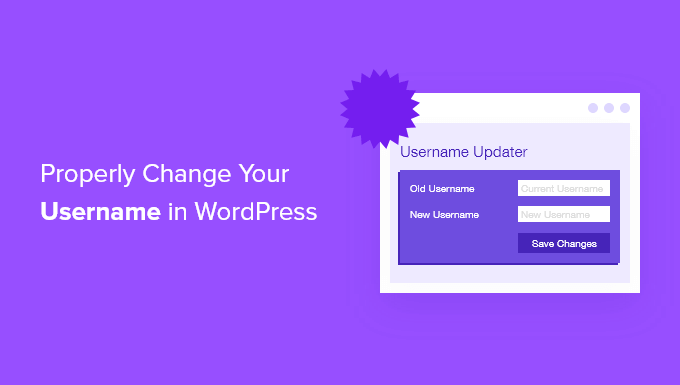
Ist es möglich, Ihren WordPress Benutzernamen zu ändern?
Es ist zwar einfach, Ihren vollständigen Namen in Ihrem Benutzerprofil in WordPress zu ändern, aber Sie werden eine Meldung sehen, dass Benutzernamen nicht geändert werden können.
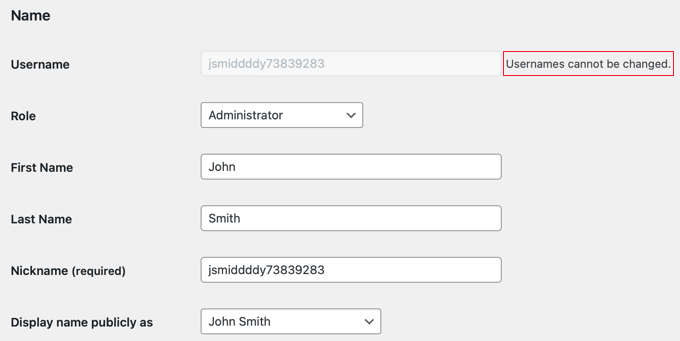
Dies kann für WordPress-Anfänger frustrierend und verwirrend sein. Die gute Nachricht ist, dass es mehrere Umgehungsmöglichkeiten gibt, um Ihren WordPress-Administrator-Benutzernamen und andere Benutzernamen zu ändern.
Dieser Artikel zeigt Ihnen drei Möglichkeiten, wie Sie Ihren Benutzernamen auf Ihrer WordPress-Website ändern können. Sie können die Links unten verwenden, um zu der Methode zu springen, die Sie verwenden möchten:
Methode 1: Erstellen Sie einen neuen Benutzer und löschen Sie den alten (kein Plugin)
Der einfachste Weg, Ihren WordPress-Benutzernamen zu ändern, besteht darin, einen neuen Benutzer mit dem gewünschten Benutzernamen und der Administratorrolle anzulegen.
Der einzige Haken an der Sache ist, dass Sie eine andere E-Mail-Adresse verwenden müssen als die, die Sie für Ihr derzeitiges Konto nutzen.
Hinweis: Wenn Sie Gmail verwenden, können Sie ein Pluszeichen (+) mit zusätzlichen Buchstaben nach Ihrem Benutzernamen einfügen.
Wenn Ihre E-Mail-Adresse zum Beispiel myname@gmail.com lautet, können Sie die E-Mail-Adresse myname+wordpress@gmail.com verwenden. Sie wird immer noch an denselben Posteingang weitergeleitet, aber WordPress betrachtet sie als eine separate E-Mail-Adresse.
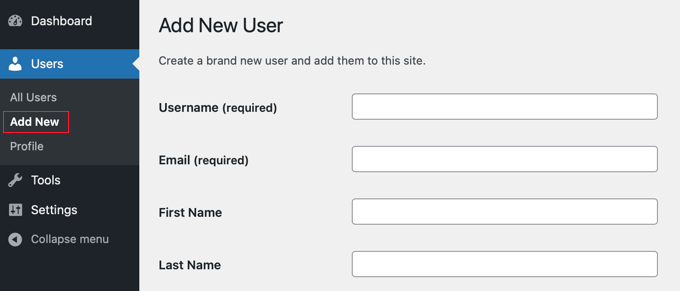
Nachdem Sie das neue Konto erstellt haben, müssen Sie sich von Ihrem WordPress-Konto abmelden und dann mit dem neuen Benutzerkonto anmelden, das Sie gerade erstellt haben.
Gehen Sie als Nächstes auf die Seite Benutzer “ Alle Benutzer in Ihrem WordPress-Administrationsbereich und klicken Sie dann auf den Link „Löschen“ unter Ihrem alten Benutzernamen, um ihn zu entfernen.
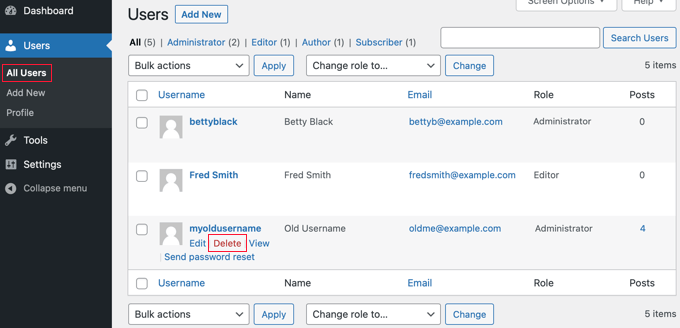
Wenn Sie den alten Benutzernamen löschen, wird WordPress Sie fragen, was Sie mit den von diesem Benutzer erstellten Inhalten tun möchten.
Vergewissern Sie sich, dass Sie auf die Option „Alle Inhalte zuweisen an“ klicken und dann den neuen Benutzer auswählen, den Sie gerade erstellt haben.

Danach sollten Sie auf die Schaltfläche „Löschung bestätigen“ klicken, um das alte Benutzerkonto zu löschen.
Herzlichen Glückwunsch, Sie haben nun erfolgreich Ihren WordPress-Benutzernamen geändert. Wenn Sie dieselbe E-Mail-Adresse wie zuvor verwenden möchten, können Sie jetzt die E-Mail-Adresse des neuen Benutzers ändern.
Methode 2: Ändern des Benutzernamens mit Hilfe eines Plugins
Eine weitere einfache Möglichkeit, Ihren WordPress-Benutzernamen zu ändern, ist die Verwendung eines Plugins. Wenn Sie sich Sorgen machen, dass Sie zu viele Plugins verwenden, dann können wir Ihnen versichern, dass Sie das Plugin sicher löschen können, sobald Sie Ihren WordPress-Benutzernamen geändert haben.
Als Erstes müssen Sie das Plugin Easy Username Updater installieren und aktivieren. Weitere Einzelheiten finden Sie in unserer Schritt-für-Schritt-Anleitung für die Installation eines WordPress-Plugins.
Gehen Sie nach der Aktivierung einfach auf die Seite Benutzer “ Benutzername aktualisieren und klicken Sie dann auf den Link „Aktualisieren“ neben dem Benutzernamen, den Sie ändern möchten.

Geben Sie nun einfach den neuen Benutzernamen ein und klicken Sie dann auf die Schaltfläche „Benutzernamen aktualisieren“.
Wenn Sie den Benutzer über die Änderung benachrichtigen möchten, müssen Sie zuerst das Kontrollkästchen „Benutzerbenachrichtigung senden“ aktivieren.
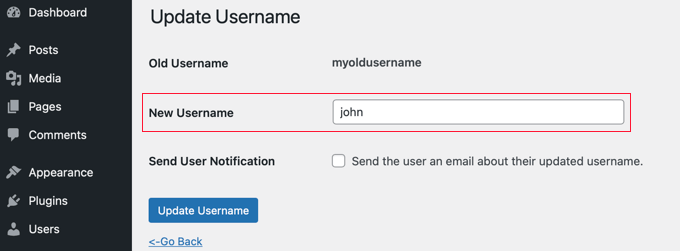
Das war’s schon! Jetzt können Sie das Plugin zum Ändern des Benutzernamens von Ihrer Website entfernen.
Methode 3: Ändern Sie Ihren WordPress Benutzernamen mit phpMyAdmin (Fortgeschrittene)
Diese Methode ist etwas kompliziert, da sie direkte Änderungen an Ihrer WordPress-Datenbank erfordert.
Wir empfehlen, dies nach Möglichkeit zu vermeiden, da es leicht zu Fehlern auf Ihrer WordPress-Website kommen kann.
In manchen Fällen haben Sie jedoch keine andere Wahl, z. B. wenn Sie Ihren WordPress-Benutzernamen und Ihre E-Mail-Adresse vergessen haben und von Ihrem Administratorkonto ausgesperrt werden.
Zunächst müssen Sie sich in Ihr Webhosting-Dashboard einloggen, um das phpMyAdmin-Menü zu finden.
In diesem Beispiel verwenden wir Bluehost. Ihr Dashboard kann anders aussehen, wenn Sie einen anderen Hoster verwenden, der kein cPanel einsetzt, aber die phpMyAdmin-Option sollte trotzdem verfügbar sein.
Sobald Sie sich im Bluehost-Dashboard befinden, navigieren Sie zur Registerkarte „Websites“. Wählen Sie dann eine Website aus und klicken Sie auf die Schaltfläche „Einstellungen“.
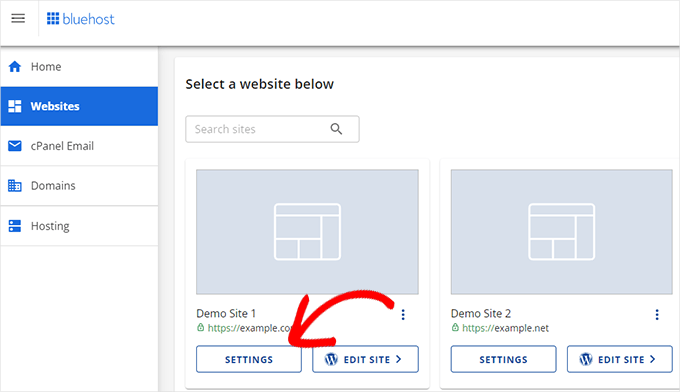
Blättern Sie nun nach unten zum Abschnitt Quick Links.
Danach klicken Sie einfach auf „phpMyAdmin“.
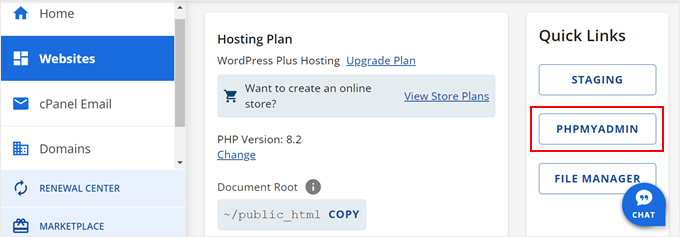
Dadurch wird phpMyAdmin in einem neuen Browser-Tab gestartet.
Sie müssen Ihre WordPress-Datenbank auswählen, wenn sie nicht bereits ausgewählt ist.
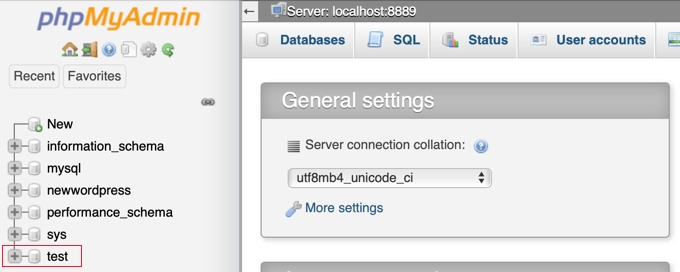
Sie sehen nun Ihre WordPress-Datenbanktabellen. Standardmäßig verwenden WordPress-Datenbanktabellen wp_ als Präfix vor jedem Tabellennamen. Es ist möglich, dass Sie das Datenbankpräfix in etwas anderes geändert haben.
Klicken Sie auf die Tabelle wp_users auf der linken Seite. Dann klicken Sie auf „Bearbeiten“ neben dem Benutzernamen, den Sie ändern möchten.

Nun können Sie den neuen Benutzernamen, den Sie verwenden möchten, in das Feld user_login eingeben.
Wenn Sie fertig sind, müssen Sie auf die Schaltfläche „Go“ am unteren Rand des Bildschirms klicken, um den neuen Benutzernamen zu speichern.

Das war’s schon! Jetzt sollten Sie sich mit Ihrem neuen Benutzernamen in Ihrem Dashboard anmelden können.
Weitere Möglichkeiten zur Verwaltung von WordPress-Benutzern
Möchten Sie weitere Tipps und Tricks zur Verwaltung Ihrer WordPress-Benutzerkonten? Hier sind weitere Artikel, die Sie lesen können, um loszulegen:
- Wie Sie Ihr Passwort in WordPress ändern (Anleitung für Anfänger)
- Wie man Benutzern in WordPress starke Passwörter aufzwingt
- Automatisches Abmelden von inaktiven Benutzern in WordPress
- Hinzufügen oder Entfernen von Berechtigungen zu Benutzerrollen in WordPress
- Wie man einen WordPress Benutzer sperrt, ohne sein Konto zu löschen
- So begrüßen Sie jeden Benutzer mit einer individuellen Willkommensnachricht in WordPress
- Hinzufügen zusätzlicher Benutzerprofilfelder bei der WordPress-Registrierung
Wir hoffen, dass diese Anleitung Ihnen geholfen hat zu lernen, wie Sie Ihren WordPress Benutzernamen richtig ändern. Vielleicht interessieren Sie sich auch für unsere Anleitung zum sofortigen Wechsel zwischen WordPress-Benutzerkonten und unsere Expertenauswahl der besten Plugins zur Verwaltung eines WordPress-Blogs mit mehreren Autoren.
Wenn Ihnen dieser Artikel gefallen hat, dann abonnieren Sie bitte unseren YouTube-Kanal für WordPress-Videotutorials. Sie können uns auch auf Twitter und Facebook finden.




Syed Balkhi says
Hey WPBeginner readers,
Did you know you can win exciting prizes by commenting on WPBeginner?
Every month, our top blog commenters will win HUGE rewards, including premium WordPress plugin licenses and cash prizes.
You can get more details about the contest from here.
Start sharing your thoughts below to stand a chance to win!
Anjan Lohar says
Thank you for this, super easy. I’m always like to change my user name using 3rd method.
kathy says
Thank you for this, super easy.
WPBeginner Support says
Glad you found our guide helpful
Admin
Layla Turner says
Thank you so much for this post! The ‚add new user‘ then ‚delete old user‘ & ‚attribute to new user‘ worked for me.
And I now have the plugin which also works.
FYI – when I changed the email address after adding new user, it took aaages for the confirmation email to come through to my Gmail from WordPress.
WPBeginner Support says
Glad it worked, setting up SMTP can also help with email deliverability if someone hasn’t set that up yet.
Admin
Desmond Diangha says
Wow, this is just awesome, and any other article i have read here is just so great and very useful. I just succeeded in adding a new user for my website after reading this article thanks a lot….
WPBeginner Support says
You’re welcome, glad our guide was helpful
Admin
Rahat says
That was really helpful. I was searching for the solution and some websites suggest to install a plugin, which is not the best solution for me,
because that would make my site slower.
Since I am familiar with PHP, so it would be better to use PHPMyAdmin in Cpanel.
And that’s what I did with the help of this article.
Thanks
WPBeginner Support says
Glad our article could help, in general a plugin should not slow down your site unless it is poorly coded.
Admin
Kendall Watson says
Thank you for this post. After attempting the cpanel method, which didn’t work, I found this and the plugin suggestion did work.
WPBeginner Support says
Glad our guide was able to help
Admin
Dharmendra says
I tried method 1 but it did not work, then tried method 2 and it worked. Thank you so much
wpbeginner is a rock. Every time I get a solution.
WPBeginner Support says
Glad our guide was able to help
Admin
Tom Llobet says
NEVER USE „admin“ or the domain name as a user, this is the first thing hackers use to get access to the backend.
WPBeginner Support says
Thanks for sharing this, we agree that users should avoid using the username admin
Admin
Van says
Using phpMyAdmin worked like a charm for me. I wanted to change my username because I discovered while perusing Wordfence brute force activity on my site that my username had been used by a hacker.
WPBeginner Support says
Glad our recommendations could help
Admin
Stef says
Doing it in the database won’t wipe anything out like their orders if WooCommerce?
Daniel says
Thank You! php way worked perfectly!
Bonkarah says
Appreciate the info given here. I was able to use PhpMyadmin to change the user name. But on logging in to my WordPress site, the info on my dashboard is so limited. The new username that was there before i deleted the wrong one with Admin role had Author’s role. Could this be why I am not granted full access to my editing dashboard where I could add more users and edit normally?
Somebody help me out here. How do I get back to my full dashboard editing suite and change my role to Admin?
Jake says
Why won’t your website let me create an account? When ever I try it says to try again with no explanation.
WPBeginner Support says
Hi Jake,
Where you are trying to sign up? If you are trying to join WPBeginner Videos, then we just tested the form its working fine.
Admin
Linda Groeneveld says
I have used the plugin ‚username changer‘ and now my account is gone?! What happend and how can I undo this?
WPBeginner Support says
Hi Linda,
Try to recover the password first. If this fails, then you can try resetting admin password via phpmyadmin.
Admin
Kimberly says
Thank you so much. You just saved my laptop from going through a window.
Tyler says
I tried doing this to edit the nice-name attribute, so I don’t leak my user name on the Author’s page, and now my site only shows: Error establishing a database connection. Even after re-naming the field to its original value it doesn’t fix it. Any suggestions?
Jenny Zentz says
Thank you! Finding so much help for setting up my new WP account. I’m transferring an existing blog from Blogger. (And existing Google domain.) Any things you’ve already done on that would be great!!! I’ll be searcher your site a lot!
kari says
just successfully used the plugin to change my user name – it was really easy then just deleted the plug in – really really useful – thank-you
Naman says
Hi i can not find username changer under users
Ripunj says
You can simple do this without the plugin. You have to create a user, and for that you have to click on Add New button in the Users section, input the username whatever you want to and then assign the role of it to Administrator then log out. Now log in using newly created username and go into the same section that is Users and now can simply delete the old admin user.
Heather says
Hi There. It did seem to work, but it did not attribute all the content. So my bio, my social media links, and Gravatar photo are gone. I can’t figure out how to get all that back.
Colin Crawford says
Hi
I can’t get this to work, I have tried other tutorials and they say just the same.
I am in the right database as there is only one and I have edited the old admin username that was originally set up i.e. admin and it won’t allow me to login.
In the database it has clearly changed but when I try to login it won’t allow me. So using the old admin username gets me back in but how? it has been changed it doesn’t exist anymore….
If I view the Users in WordPress my new username is not there so where is it getting these details from?
I am truly baffled.
Colin
Gary Armstrong says
You may want to try changing the password to your admin user within wordpress. It would be good to have another temp Admin level user in WP as a backup.
If you’re using phpmyadmin, open the password field, choose a new password and IMPORTANT! choose the MD5 function (or this will NOT work).
Once you change the password, try logging in to your old username account. Try doing this in Incognito mode in Chrome so you have NO cookies set. It shouldn’t let you login. If it IS still logging in, double check you’re in the right DB. I know you said you were, but check the wp-config.php file anyhow.
Extra hint. If you don’t want to setup another email address, and you use Gmail, you can add a + to the end of a gmail address and it will go to the same mailbox: e.g.
Colin Crawford says
Hi
Thanks for the reply Gary, I ended up deleting everything on that domain name as it had other WordPress installations so somewhere it went wrong.
Once I did this the information in the tutorial worked but it was so frustrating why it didn’t.
Good job I only used that domain name for testing websites.
Cheers
Colin
Anyaogu Ikechukwu says
Hello. I thank you for sharing this article. I want to know if it is necessary to change your username after installing WordPress
WPBeginner Support says
If you are using a username like admin, administrator, then yes you should change it.
Admin
Brigitte says
thank you thank you. When I am in troubles I always find a helpful answer in your website. Kind regards!!
Melissa says
How do I even find my cPanel login details? My site is hosted by GoDaddy but built on WordPress, and the GoDaddy account belongs to my editor. I keep asking him if he can find out but it’s been weeks now. My website was restored by someone else who had another kind of access point, but I need that login. How exactly do I find out those details because my WordPress login isn’t the same.
Ted says
it won’t work. i added a new admin (while still keeping the old), but when i log out, it won’t log me back in using the new admin and password (which i didn’t change!). not sure what to do now. help!
Val says
I used the first method and I am unable to delete the other user. Has anyone run into this issue? Now that I have another user with the username I actually want I am concerned that I can’t move on to method 2 or 3 because the username is already in use.
Sarah Sullivan says
Hi, My site is still under construction, when I was setting it up I followed the steps I had printed out instead of listening to the audio too. I only realised afterwards that I shouldn’t have used my real email address as the username as this will be visible once I start posting. Which method above would you recommend I follow to make the necessary change as I haven’t yet got any content to worry about losing?
The other thing I keep getting really confused about is when I am asked for my email address do they mean my real one or the one that is part of website that I would like to handle?
Thanks
Sarah
WPBeginner Support says
Sarah you can add as many users account to your WordPress site as you want. Simply go to the Users page in admin area and then click on add new. You can add users with different roles like administrator (site owner), editor, author, etc. If you are the only one using your site, then a user with administrator role is all you need. After you have created a user name that you like, feel free to delete the old one that you do not wish to use anymore.
The email address they ask will be used to send you notification emails. It has to be any existing email address that you already use.
WordPress itself is not an email client and it will not create an email address as part of your website. If you want to have a branded email address with your own domain name like sarah@example.com, then see our guide on how to setup a professional email address with Google Apps and Gmail
Admin
iulian says
Great tip. Thank you!
Niaz Khan says
Thank you, admin, after reading your blog I have successfully changed the usernames of my blog bestcmsplugins.com ,
You are doing a great job by helping others
Kellie Grace says
This was so quick and simple! Thank you so much!
Julio Falconi says
I did it and when i went on my new account it doesn’t show users tab or any other tabs
Angel A. says
Thank you so much! The first method worked flawlessly.
Alan Cox says
At last someone who really makes it easy. Well done and thank you.
Danstan says
Thanks
ERic says
Thank you. The Plugin worked perfectly
Vijay says
Thank you so much for this article. I took the phpMyAdmin route and it worked… But, before it started working it did this weird thing where if I entered the url of the user’s profile it took me to the home page.
But then in the end it worked. Probably because I saved the profile from wp-admin after having changed the user_login and the user_nicename values from phpMyAdmin?
Daniel Taylor says
That’s for the great advice. The plugin was the most easiest way.
madivad says
Too many places to reply so I’ll create a new comment.
I’m one of those people that don’t like to just add another plugin (even if I can remove it afterwards) and so even after reading about the create new user/delete user/migrate posts method, I liked the phpmyadmin method.
But it does cripple multisite installs and you really should update the main post about that.
For anyone who does do it the database way, you have to go into your sitemeta table and update the superadmin user with the new username and character count in the S:flag.
Otherwise, the create/delete/migrate method might actually be a better option
Cassy says
Here is the way I did it – very quick and easy, took me less than 5 minutes to do:
1. Go to users
2. Click on the user name you want to change
3. Above the “Update Profile” button, there will be text that reads “Were you looking for your API Key and other Personal Settings”. The ‘API Key and other Personal Settings’ text will be highlighted (as it is a link).
4. Click on this highlighted text.
5. Scrolls down the page to the heading “Account Details”
6. Just under “Account Details” will be ‘User Name’
7. You will see next to your user name there will be the word ‘Change’ in brackets, also in highlighted text (indicating it is a link).
8. Click on this text to change your user name.
9. Don’t forget to save
10. You can change all other linked settings from here, such as BLOG NAME, PRIMARY BLOG, etc,
Traci says
Hello,
Thanks for the article! Out of curiosity, would a change of my WP login username prompt a DISCONNECT to wordpress.com jetpack stats and tools?
I’m asking b/c today, I changed it (due to tireless notifications of site lockout attempts from….who knows?), and now my jetpack stats are all screwy and wordpress.com no longer recognizes my website. I’m getting this error message:
unknown_token: It looks like your Jetpack connection is broken. Try disconnecting from WordPress.com then reconnecting.
But no further instructions on what to do. Love to know your thoughts.
Thanks! LOVE your all of your content!
Chris says
A word to the wise, from someone who wasn’t. Using that plugin can be fatal to a multisite setup. Multisite does not allow the user name of the superadmin to be changed. And there is no warning about this on the plugin site. But because the plugin just twiddles with the name fields of the database it gaily ignores this. So if you use it, be prepared to lose all access to the network. This might not happen if the name you change it to happens to have the same number of characters as the name you are changing from. I am not about to prove this point though, once bitten and all that. The remedy is then only direct editing of the database to restore precisely, and I do mean precisely including cap and lower case usage, what was there before.
Miha says
Hi,
i successfully changed username on the multisite installation.
I have changed username directly in sql database.
First of all backup your db.
You have to change username in tables:
_users in fields: user_login and user_nicename
_usermetadata field nickname and
_sitemeta field site_admins
in the field site_admins be careful to change the name admin and number of letters before admin in variable s:5
admin username has 5 letters, change it to number of letter in your new name
Delete cookies in browser, login again to your WP admin and you have network access with your new username
Frank says
Does it make sense to change the user ID as well?
Bob The Builder says
Here is something odd that I’ve noticed today.
I did not like it that my (admin) username was visible in the author URL. So I decided to create a new user with author role and since I’ve made this new user the author URLs are the same as the screennames.
So now I can use my admin account again since the screenname is visible in the URLs and not my actual username.
Any explanation for this?
WPBeginner Support says
WordPress uses the username in the Author URLs. If the admin user still has posts then their author URL will still appear on those posts. You can assign those posts to new author account you created and set a redirect for the admin url.
Admin
Paul Okeke says
Everything about WPbeginner.com is awesome. This article and all I have come across from the same source worked for me. Just want to say a big thanks to wpbeginner.com editorial saff. Cheers!
Adriana says
Would the process „Create a New User and Delete The Old One“ work properly from network admin area on a multisite installation?
Muhammad says
It worked! Many thanks!
MattFromGA says
This change may or may not be a big problem for a given wordpress site based on the plugins and theme it is using. What if there is a plugin that uses an external system that associates data with username? The simple change outlined here would fail to update that username in the external system and the association between the user and that external data would be broken with this change. What about forum posts in bbpress where a user mentions another user by username?
I guess a basic wordpress blog install wouldn’t have too many problems with this, but beyond that you better have awareness of the other plugins and theme dependencies on username. If none, this simple change could be fine.
Rose says
Yes And we’ve seen this week where this all can lead to. Patching up plugins, fixing holes, hoping the theme has no holes, then after seeing the notorious scammers all have the name, changing username etc. But luckily we can change the name. There’s no other option when all is leaked out. Yes security. Having a good security plugin. Securi I found too difficult to understand. Anyway, there are certainly more problems to fix soon.. boy oh boy.
Braham Dutt Sharma says
Hi, I want change my existing blog authority in another login id example: i make 5 blog with my own id and now i want change 1 blog login and password with another email is , can this possible , if possible please help.
Tyler says
There is nowhere else it needs to change. Everything is attributed to the ID of the user, not the username. It’s just a text field like email, first_name etc.
MattFromGA says
So you have a certainty that ever plugin and theme written for wordpress follows that guidance? What about plugins that share username with external systems which make data associates with that?
Morphine Child says
Wow, did phpmyadmin solution… literally 3 seconds of work…
Big thank you!
adeem jan says
Yet another informative tutorial from you
Let me tell you honestly, I am totally the non-techie so I had NO idea about how to change the admin username till some time back – nor do I visit the C-Panel – I fear those places…lol…
My friend takes care of the tech aspects, though I’ve learnt it all now and thanks to you all of you tech bloggers sharing your posts here, I keep learning each day!
Yes, for security reasons, you need to change the usernames, more so with the number of cases of hackers all over the web. Better to be safe than sorry later.
Thanks for sharing.…. keep up the good work…
Jatin Chhabra says
Well the 1st ine didn’t work but the 2nd one did…